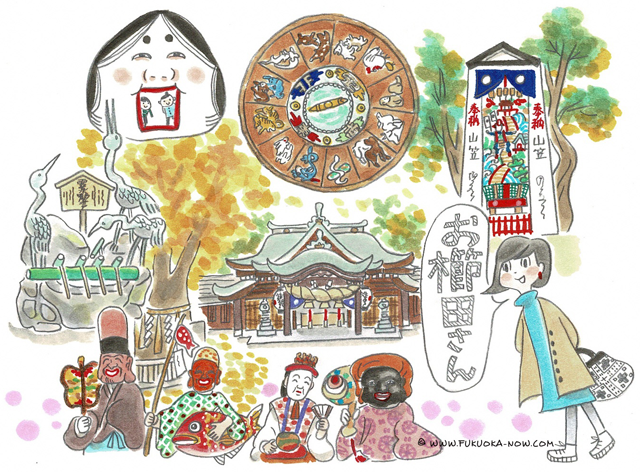Hakata Culture vol.167
Okushida-san: The Shrine of Hakata’s Guardian Deity

Kushida Shrine, referred to affectionately by locals as Okushida-san, has been home to the city’s guardian deity since olden times. Although Kushida Shrine has been mentioned several times in this column over the years, oddly, it has never been officially showcased. Kushida Shrine traces its history of protecting Hakata back more than 1,260 years to the year 757 when it was first built. Amaterasu, the sun goddess and the highest deity in Japanese mythology have been enshrined here since before the shrine was erected.
There are many things to see inside Kushida Shrine. If you are going for the first shrine visit of the new year, remember to check the lucky direction on the etoehoban, a disc depicting the 12 signs of the zodiac which can be found on the ceiling of the Sakuramon gate. Every New Year’s Eve, the disc is rotated to align with the coming year’s zodiac animal and show the lucky compass direction for that year. Known as Kushida no Ginan, the massive ginkgo tree in the shrine is sacred. (Note: Ginan is the Japanese name for ginkgo nuts.) Considered a symbol of longevity, the tree’s leaves turn golden yellow in the fall.
Next to the main hall, you will find the Sacred Crane Well. The underground spring water that feeds this well is said to grant longevity and eternal youth. (But the water tastes salty and bitter like seawater.) Kushida Shrine is also famous for its seasonal festivals. The largest otafuku mask in Japan is erected ahead of Setsubun in February, and the Hakata Gion Yamakasa held in July is renowned throughout Japan. Dating back over 700 years, this festival, which features men in loincloths racing massive floats, has been inscribed by UNESCO on the Intangible Cultural Heritage List. Other local festivals include the Hakata Matsubayashi in May and the Hakata Okunchi in October.
Kushida Shrine is also the only place where you can see a kazariyama (decorative float) year-round. These are typically only put on display during the Yamakasa festival period. The kazariyama is replaced with a new one every year before Yamakasa begins. If you want to learn more about Kushida Shrine and Yamakasa, then stop by the Hakata History Museum located on the shrine grounds. The displays feature high-quality historical documents and shrine treasures. In fact, Kushida Shrine is home to the Kushida Bunko, thought to be Japan’s oldest library.
“お櫛田さん”は博多の総鎮守
博多っ子たちが尊敬と親しみを込めて“お櫛田さん”と呼ぶ櫛田神社は、古くからの博多の守り神。このコラムでも何度か名前が登場していますが、正式に紹介していなかったのが不思議なくらいです。757年の創建とされ、博多の町を見守り続けて1260年以上の歴史があります。最も古い祭神・天照大神(あまてらすおおみかみ)は、神社の創建前から祀られていたとも言われます。
境内には見どころがいっぱい。初詣なら、楼門の天井につり下げられた干支恵方盤をチェック。毎年大晦日に新しい年の恵方を示すように回転させます。大きな銀杏の木は“櫛田のぎなん”と呼ばれる御神木。長寿延命のシンボルとされ、秋には黄金色に染まった葉が見事です。本殿脇にあるのが“霊泉鶴の井戸”。地下から湧き出る不老長寿の水とされ、海水のような苦味と塩辛さです。
年間を通して行われるさまざまな祭も有名。2月の節分大祭では、日本一大きな「おたふく面」が設置されます。7月は全国的に知られる博多祇園山笠の季節。700年以上の歴史があり、締め込み姿の男たちが疾走する迫力ある様子はユネスコの無形文化遺産にも登録されています。このほか5月の博多松囃子、10月の博多おくんちなど、地域に欠かせない祭事が行われています。
本来、山笠の期間しか見られない「飾り山」が1年を通して見られるのも櫛田神社だけ。毎年、山笠の季節には新しい飾り山に作り替えられます。櫛田神社や山笠の歴史について学びたければ、境内にある博多歴史館を見学するのもおすすめです。価値の高い資料や神社の宝物が展示されています。櫛田神社は、日本最古の図書館とされる「櫛田文庫」が開かれた場所でもあるのです。

